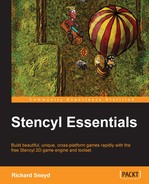The world of game development has been in a state of flux for the past few years. New technology, as well as new development tools and frameworks, has diversified the games industry and opened up the field to those who may not otherwise have been in a position to realize and publish their game concepts.
Stencyl is one such innovation. Developed from the ground up by founder Jonathan Chung, to be as accessible as possible to as many people as possible, yet it still retains the awesome power necessary for professional-level developers. Stencyl makes it possible for anyone with a great idea and the right motivation to develop their own games, from concept to market.
Stencyl Essentials has been written to get you up and running with Stencyl faster than with any other book, as it has been written in terse, yet lucid prose with a no-nonsense style, enabling you to get to grips with Stencyl in a fun, yet fast-paced way. This book is centered around a project, which has been designed to reinforce all of the key learning objectives. You will be guided through the process of building a game prototype, which is based on a successful, published game called Mudslide Cowboy (CyberMyth Games). By the end of this book, you will be competent in the use of all of Stencyl's most important features, and quite prepared to start working on your own game projects.
Chapter 1, Exploring the Stencyl Toolset and Game Engine, introduces the Stencyl toolset and interface, demonstrating how to navigate through all the most important screens.
Chapter 2, Starting the Game Project, explains the game concept, which we will be working on in the subsequent chapters, and guides you through the process of creating your first game project.
Chapter 3, Backgrounds and Tilesets, explains how to import Backgrounds and Tilesets and how to configure their settings, in preparation for use in our game levels.
Chapter 4, Building Levels Using Scenes, explains how you can learn to utilize backgrounds, foregrounds, and tiles to sculpt a visually compelling and varied game level.
Chapter 5, Actor Types and Instances, introduces you to the process of importing, customizing, and configuring actors, which can then be made interactive through using actor behaviors.
Chapter 6, Writing Simple Behaviors, teaches you the process of building the game logic using the signature block-snapping interface of the Behavior Designer in Stencyl.
Chapter 7, Complex Behaviors and Code, digs deep into the incredible power of Stencyl's visual programming system, showing you how to harness it at a more advanced level.
Chapter 8, Adding Sound FX and Music, explains how Stencyl handles audio, and then guides you through the process of importing sound files, configuring them, and playing them in-game.
Chapter 9, Adding HUD Elements, shows how we can use actors in a special way to create animated elements of our heads-up display.
Chapter 10, Adding Menus and Buttons, guides you through the process of creating a Start screen and adding functional buttons to it.
Chapter 11, Scoring and Game Rules, helps you implement a game rule, based around the collection of gold coins, that will aid us in measuring success or failure during play sessions.
Chapter 12, Publishing and Monetization, gives us a clear overview of the principal publishing and monetization available to game developers in Stencyl.
